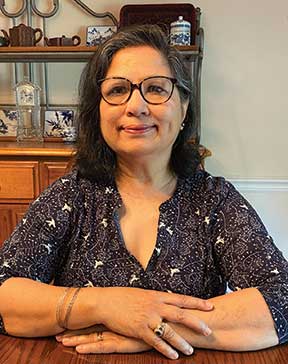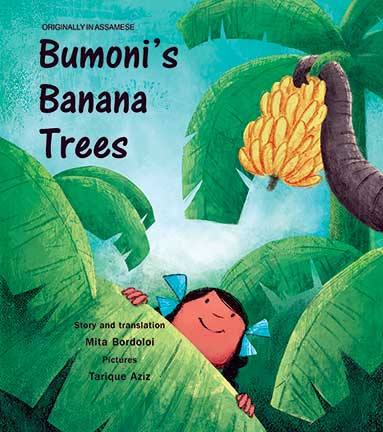Chintan Girish Modi

Mita Bordoloi likes to describe herself as “a mother of three daughters, a lover of animals and plants, and a writer of stories for adults and children”. Her creativity is nourished by the cultures and geographies that she has been intimately connected to. While she was born in the valley of the Brahmaputra river in northeast India, the land of the Mississippi in the United States has been her home for the most part.
Bordoloi’s gift for storytelling has captivated the imaginations of readers as well as award committees. Bumoni’s Banana Trees, the picture book that she created in collaboration with illustrator Tarique Aziz, won the Neev Book Award 2022 (Early Years) and the Green Literature Festival Honour Book Award 2022. Produced by Tulika Publishers, this book is recommended for readers who are above the age of four.
Bumoni is an endearing protagonist. She loves eating bananas and getting her fill is easy because they grow in her backyard. Since there is an abundance of banana trees, her family uses them in multiple ways. Her brother uses the stems to make bowls while her mother cooks the banana blossoms. Her father makes a boat using longer banana stems when he goes fishing in the river, and her sister lays out banana leaves on the ground just before meals are served so that these can be used like plates when they eat together.
The used banana leaves are not treated as garbage. They are tossed into a pit so that hungry cows can use them as food. Without being pedantic or prescriptive, the author communicates how nature takes care of us and how we can do the same by being grateful, sharing, and recycling.

Bumoni lives close to the Kaziranga National Park, so she is able to hear the sounds of elephants, tigers, rhinos, hoolocks, and many kinds of birds. If she is lucky, she even gets to see some of them by the river when they come out at sunset. Aziz’s illustrations help readers enter this majestic landscape that can be both beautiful and scary.
Read this book to find out what happens when a herd of wild elephants crossing the river land up in Bumoni’s backyard and gobble up the bananas and banana leaves over three consecutive nights. Like the rest of her family, Bumoni wants to prevent the elephants from returning. At the same time, she wants to ensure that they have sufficient food to eat. She hits upon an excellent idea.
This book is charming not only because a child – rather than an adult – saves the day but also because it shows that conflicts can be resolved in healthy ways that fulfill the needs of both parties. Children will come up with several other observations, perspectives and questions when they read the text and engage with the illustrations. Parents, teachers, grandparents or siblings who read the book along with children can also introduce them to recipes that use different parts of banana trees. Wherever possible, children can also be taken to the market where different kinds of bananas are available so that they get to learn what makes each one unique and for what purposes they are used.
We bring you an interview with Mita Bordoloi.
What was the starting point for this story? Did you begin with Bumoni as a character or the idea of a human-animal conflict, or banana trees? How did you develop it further?
The human-animal conflict was on my mind. It was important to me that they lived sustainably side by side, balancing the natural habitat. Bumoni’s feisty character emerged spontaneously in this setting. Bumoni is a common and endearing Assamese name. It was further developed from the scenes taken from my lived experiences. We had endured many attacks by wild elephant herds on our paddy fields, banana groves, and sugarcane cultivation when I lived in the setting of the book in Kaziranga.
What aspects of your childhood did you draw inspiration from while writing this book? To what extent is Bumoni based on you as a child?
When I lived on the periphery of Kaziranga National Park in my teens, elephants did come to eat our bananas and sugarcanes at night. I naturally loved animals and had empathy for them. I did think of finding solutions to this ongoing problem. In that sense Bumoni’s empathetic heart resembles mine.
You wrote the story in Assamese before translating it into English. What was the process like? Were there words or concepts that were challenging to translate?
When I originally thought of Bumoni and her story, I didn’t think that she would be speaking English. She was a village girl from the outskirts of Kaziranga. She authentically spoke her words in Assamese to me. It made sense to have the original language of the book to be in Assamese.
It might be interesting to note that I used the word ‘ranger’ in my Assamese version because I thought it was a word that had permeated the lives and vocabulary of people who lived near the Kaziranga National Park even though they spoke Assamese. But I was happy that in the Bengali version it was described as the people who took care of the national park and in the Hindi version as the employees of the jungle.
Were elephants an important part of your formative years? Could you recall for us the first time that you saw an elephant?
I was born in the Digboi oil town. Elephants were regular visitors there as well. In fact, oil was first discovered in Assam by a logging elephant. My first glimpse of an elephant was a domestic one, but my first thrilling moments of seeing wild elephants were in the Kaziranga area. A herd of wild elephants woke us up at night making crackling sounds behind our house. They were gobbling up our sugarcanes.
Did you spend a lot of time at Kaziranga National Park?
I spent about five years in the Kaziranga area as a young girl.
What kind of research went into the process of writing this book?
This book wrote itself organically from my lived experience. It did not need any serious research.
Would you like to share anything else about the backstory that led to the book?
Lately, while watching YouTube videos, I was appalled and enraged by people’s wild, loud, and rowdy reactions to the gentle beasts crossing through their age-old corridors. I did not want the next generation of humans to grow up as insensitive to wild animals. I wanted to inculcate empathy, especially at the grassroots level. So, I bought a big chunk of the Assamese version of the books and donated them to wildlife NGOs such as Aaranyak, Hati Bondhu, and Wildlife Trust of India (WTI), to be distributed to the children living in the elephant corridors of Assam. The idea was that it will be replicated in West Bengal and elsewhere as well. I had read in WTI’s website that a young schoolteacher was giving sensitivity training in the five elephant corridor areas of north Bengal. Another young WTI staff member who specialized in elephants had liked the idea when I had brought it up in an email, but, of course, action is difficult to come by, or match my enthusiasm.
I also wanted a depiction of sustainability, renewability, and biodegradability of the banana trees in minute details. For instance, I wanted the bowls made from the banana stems to be the rectangular ones called ‘khul’ in Assam, and Tarique (the illustrator) being from Assam delivered them as accurately as I had envisioned. I think ‘khuls’ are peculiar to Assam, and they are used extensively in the Namghor/monasteries during gatherings for distribution of prasad or meals. I took poetic license to bring this unique piece of culture to the book.

Tarique Aziz is an illustrator, designer and nature lover from Assam. He is fond of reading about marine line and dinosaurs in his spare time. He has illustrated many books for children including Jamlo Walks written by Samina Mishra, When I Grow Up written by Priyadarshini Gogoi, and What’s That Smell? written by Ashwitha Jayakumar.
How was the experience of illustrating this book, especially as it is set in Assam where you’ve grown up?
I was immediately emotionally attached to the book when I read the first draft of the story. The book was fun as well as challenging for me. There were a lot of elephants to draw and so I really had to practice drawing a lot of them in order to get it right. My father used to work in the forest department and as a child my mother used to tell me stories about wild elephants and their conflict with humans, which she had experienced when my father was working in Bokakhat, a small town in Assam, where such conflicts were very common. So it was very fascinating for me to work on the visuals for this book.
Could you tell us about the visual style that you’ve chosen for this book? You seem to have used water colours and oil pastels. Please correct me if I’m wrong.
Actually the final art is all digital. Yes, they do look like pastels because I used custom brushes which were specifically created to get that look. This style of colouring was specially created for this book. The idea was to make it look different from the ‘typical’ picture book style. So we explored a few options and finalized this one. It uses very bold strokes and a heavily textured but minimalist approach to the details and colouring.
Were you working with an art director at Tulika, or only with the editor and Mita? How did their suggestions contribute to your images?
I worked closely with the designer at Tulika and author Mita Bordoloi and their feedback for each spread really helped elevate the entire book’s artwork to a whole different level.
How did you figure out the look and feel of the book, the choice of colours and textures? Do you want to add anything else?
The look and feel were developed primarily with the ambition of working in a style different from what I usually do. I was certain that I wanted to use some heavy textures for this one, so that was the first thing I finalized. Everything else was developed after a lot of trial and error and trying different variations of rendering.
The author is a bibliophile, journalist, and educator based in Mumbai. He can be reached at chintan.writing@gmail.com.
